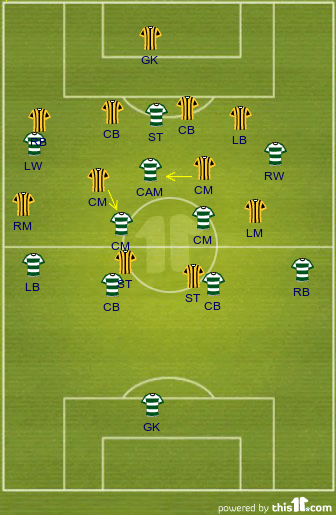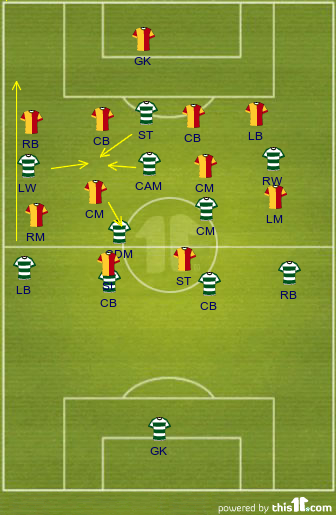So, what sets these too similar formations apart? Why is one so more effective than the other, whilst being very much alike? There are a few factors which are the answer to this question, one of them being that the 4-2-3-1 has more lines of players than the 4-4-2, this allows it to have a staggered set-up, giving a side benefits in both defence and attack.
Tactical Analysis
 |
| The free CM has no marker |
Only the most old-fashioned of managers still use the 4-4-2. This means that the formation is often accompanied with an old-fashioned playing style, usually rigid man marking with direct football to a target man up top. A man marking two man field will never work well on it's own against an opposition midfield of 3, because if the two man mark the opposition two, then the opponents will always have one player available for a pass. Even if they get support from attack and one striker drops deep into the midfield to mark the free opposition midfielder, the other striker will easily get isolated up top, unless he is a striker of a high enough ability to worry both of the centre-backs simultaneously.
Also, if a central midfielder pushes up to press a deeper lying opposition midfielder, then he will leave a space behind him which an inside forward or striker can take advantage of, as shown in the diagram on the left. This is a typical example of how easy it is to open up space against a 4-4-2 through manipulation. You force the opposition midfield to press by positioning one (or both) midfielders deep. This gives the dilemma of staying where they are and allow your two holding midfielders time on the ball - suicidal if one of them is a playmaker. Their other option is to press forward and stop them having time on the ball, which opens up space in behind them and your attacking players can use the space to create chances. This strategy isn't just for the 4-2-3-1, it can be used for a 4-3-3, 3-5-2 and the 4-5-1 to name a few.
The 4-2-3-1 however, uses a more modern zonal marking system. Despite being criticised by the rather simple English pundits, who claim that "A zone has never scored a goal", zonal marking is probably the most effective out of the two main systems. It means that, unlike the man marking 4-4-2, it won't be pulled apart and manipulated by movement. The system will maintain it's shape in defence, whereas a man marking set up wouldn't, as you can see in the diagrams.
Statistical Analysis - 4-4-2
 Mark Hughes is an example of the aforementioned old-fashioned managers, using a 4-4-2 whilst aiming to play direct and down the wings to get forward. Their direct play is reflected in their passing boards, notice how in the diagram that the majority of passes are direct, and the amount of uncompleted passes. In the match against Norwich, QPR managed to complete a poor 71% of passes. Because of their poor and long passing, Hughes' men ended up with just 45% possession against the Carrow Road side. The R's haven't had a match where they have had the majority of possession this season so far.
Mark Hughes is an example of the aforementioned old-fashioned managers, using a 4-4-2 whilst aiming to play direct and down the wings to get forward. Their direct play is reflected in their passing boards, notice how in the diagram that the majority of passes are direct, and the amount of uncompleted passes. In the match against Norwich, QPR managed to complete a poor 71% of passes. Because of their poor and long passing, Hughes' men ended up with just 45% possession against the Carrow Road side. The R's haven't had a match where they have had the majority of possession this season so far.It is difficult to have a good ball retention with the 4-4-2, as there isn't usually a player who's job is to collect the ball off of the defence, which there is in the 4-2-3-1. This is reflected in the passing statistics of Anton Ferdinand, who's passes were mainly direct clearances aimed towards the large Bobby Zamora up front. The centre-back completed just 71% of his passes throughout the match, the passing combination of Ferdinand to Zamora was the sixth highest (7) for the QPR side.
Because they had a poor retention of the ball, they defended for longer than they really had to do. For example, when Ferdinand hit one of his long passes the the Hoops' strikers, they only had a 30% chance of reaching their desired target, as he only completed 3 out of the 10 long range passes he attempted. This meant that more often than not, QPR had to defend again after clearing the ball, since it usually found itself at the feet of a Norwich player instead, who could instigate another attack for the Canaries.
Statistical Analysis - 4-2-3-1
 Swansea are much different to QPR, the Swans pride themselves on their great ball retention and fluid passing. You can see a much bigger difference between Swansea and QPR in their passing chalkboards, notice how many more passes the Swans have within their own half, something which is definitely not a coincidence is that Laudrup's side play a 4-3-3/4-2-3-1 formation, it definitely helps with ball retention. The chalkboards tell no lie as Swansea finished with 64% possession along with a 93% pass completion.
Swansea are much different to QPR, the Swans pride themselves on their great ball retention and fluid passing. You can see a much bigger difference between Swansea and QPR in their passing chalkboards, notice how many more passes the Swans have within their own half, something which is definitely not a coincidence is that Laudrup's side play a 4-3-3/4-2-3-1 formation, it definitely helps with ball retention. The chalkboards tell no lie as Swansea finished with 64% possession along with a 93% pass completion.Swansea also played just 26 long passes, just 4% of their total passes, compared to QPR's 48 long balls, which made up 17% of their total. Because of the Swans' better ability to pass out of defence, they ultimately had to defend less than QPR, since the Swans who were playing a 4-2-3-1/4-3-3 had more of the ball than their opposition, whereas Hughes' men (4-4-2) didn't.
Thanks for reading guys! Follow me on Twitter if you enjoyed the article, feedback always appreciated, whether it be good or bad!
What makes the 4-2-3-1 Better than the 4-4-2? Part 1: Staggered Positions


No comments:
Post a Comment